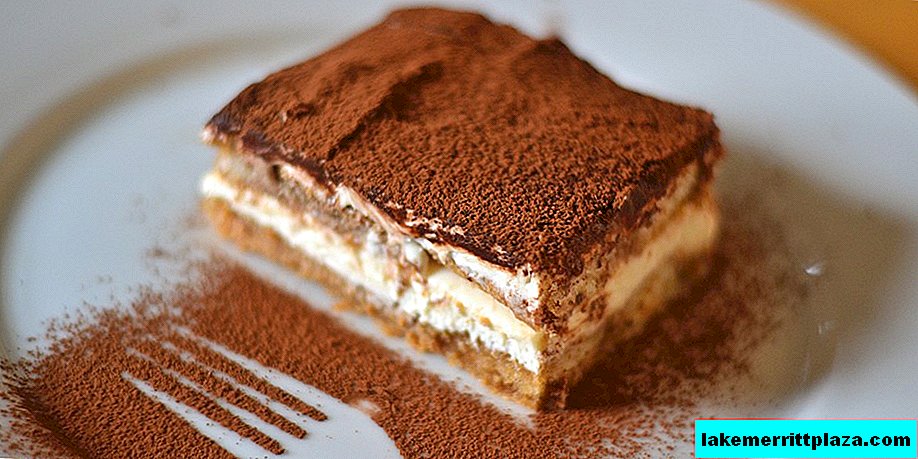If you ask people from different countries: “What Italian dessert do you know?”, Most likely, most of them will answer: “Tiramisu!” Due to the simplicity of the recipe and the unusual taste, it has become a bestseller among sweet dishes. There are so many options for it that a few years ago a hobby arose: it was imperative to order tiramisu at various restaurants in order to replenish the taste piggy bank with new sensations. In Italy they say that all families of the republic have their own kind of dessert. Moreover, everyone believes that his mother’s recipe is the best.

Story
The history of tiramisu is relatively short. He is so good that several regions of Italy fought for the right to bear the proud title "Homeland of Tiramisu": Tuscany (Toscana), Piedmont (Piemonte) and Veneto (Veneto). But the last area won with a huge margin.

Many historians are inclined to believe that his recipe was invented in the 60s in the Alle Beccherie restaurant in Treviso. Chef Roberto Linguanotto, nicknamed Loli, who had worked as a pastry chef in Germany for a long time, combined Bavarian sweets recipes with the Italian tradition of giving children a yolk whipped with sugar for overall strengthening. And so a new dessert came into being. After some time, Loli again went to Bavaria, but the love of his homeland made him return.
Colleagues ironically reproached Roberto, who had come to Italy: “Why did you invent tiramisu? Now we must work in the sweat of our faces, because customers do not ask for anything other than this dessert!”
For the first time the word "Tiramisu" appeared on the pages of the Italian language dictionary Sabatini Coletti in 1980. It literally translates as “pull me up” (Italian version of the phrase “cheer me up”). People with wild fantasies suggest that the dessert got such a name because it can act as an aphrodisiac (increase sex drive). In fact, The name of the dish is associated with its high nutritional value.
Tiramisu recipe was first published in 1983 in the book "Veneto Sweets" by Giovani Kapnista. In 1986, Paolo Zolli included it in the Dictionary of Dialects as a word born in the Veneto region.
In 2006, tiramisu was chosen as the "representative" of Italy in the series of dishes "Sweet Europe" (a list of desserts from different countries of the European Union). January 17, 2013 he was recognized as the official dish of the International Day of Italian cuisine.
Assumptions and their refutations
One of the assumptions ascribes tiramisu birth in Siena. They say that it was first prepared on the occasion of the visit of Cosimo the Old Medici and was called "soup for the duke."
But if the use of such a component of the dessert as coffee can still be confirmed (although at that time it was used only as a drink), then the mascarpone, originally from Lombardia, and ladies' fingers (cookies from the French Savoy) were hardly used Tuscan confectioners of the 17th-18th centuries. Besides, soft cheese rancid quickly, it could not be delivered from Lombardy to Tuscany. In addition, the use of raw eggs in the dessert is unlikely. The lack of storage methods increased the risk of salmonellosis.
“Duke's Soup” is not mentioned in such a classic cookbook as “The science of cooking and art is good” (La Scienza in cucina e l'arte di mangiar bene) Pellegrino Artusi.

Another version says that tiramisu was created in Torino to support Count Cavour in his attempts to unite Italy. Firstly, the middle of the XIX century did not shine with the presence of refrigerators, which excludes the possibility of storing the product. Secondly, there is no documentary evidence of this theory.
Italian chef Carminantonio Giannacone, currently residing in the United States, claims in a 2007 Washington Post article that he invented the famous dessert while in Trevisio. Such a selfish statement had no evidence and was quickly refuted.
There are many more Italian establishments trying to appropriate the authorship of the tiramisu recipe, but not one of them has a stable soil.
- Want to learn how to make a real tiramisu? We recommend attending a tiramisu workshop in Rome with a professional pastry chef.
Homemade recipe
Today, there are many variations of tiramisu. But in order to create your own unique dessert, you need to know the basis - the classic recipe.

For the original tiramisu, you will need the following ingredients:
- 500 g "Mascarpone";
- 250 g cookies "Lady's fingers";
- 80 g of sugar;
- 4 eggs;
- 1 cup of coffee;
- Unsweetened cocoa powder for sprinkling (to taste).
Inventory for preparation is quite simple: a mixer, a cup for coffee and a tiramisu mold.
As a result, you will get almost 1 kg of cake, which you can feed 6 people.
Cooking
So, let's start sculpting tiramisu:
- Make strong coffee and cool to room temperature;
- Beat the egg yolks with sugar until smooth (the mixture should lighten);
- Mix the mascarpone, which until that moment was in the refrigerator (!), With the egg-sugar mass and send again to the refrigerator on demand;
- Dip your fingers one at a time in the coffee. Liquid should not flow from cookies. It needs only to be slightly saturated;
- Take a mold and lay out a layer of cookies alternately, a layer of mascarpone until the components are finished. The last must be cream;
- Sprinkle the resulting cocoa cake and refrigerate for at least 2 hours. The ideal option is to withstand overnight.
The calorie content of the cooked dessert per 100 g is 384 kcalconsisting of:
- Protein 8 g;
- Fat 28 g;
- Carbohydrate 25 g.
If you decide to divide tiramisu into 6 people, then you need to come to terms with the fact that in your portion (157 g) there will be about 600 kcal. But, believe me, this is such a trifle in comparison with its divine taste.
- See also: Italian homemade tiramisu recipe
Recommendations

The classic tiramisu shape is round, although ladies' fingers are better suited to form a rectangular dessert. Therefore, the advice on choosing a suitable container is to choose the glass option whenever possible. It is preferred solely for aesthetic purposes: to demonstrate beautifully laid layers.
If you could not find "Lady's fingers", then any variant of biscuit cookies will do. Another way is to bake a sponge cake with a thickness of about 1 cm and cut into rectangles of 2 by 10 cm. It is better not to dip it in coffee, but to sprinkle it.
Cooking a mascarpone at home is also simple. You can read about this in our article "Mascarpone - Tender Italian Cheese."
Modern versions
In modern interpretations, tiramisu has a much larger number of components. Often used whipped proteins mixed with mascarpone to make the cream lighter, thicker and more airy.
Liqueur or fortified wine such as Marsala is added to the impregnation coffee. Just a reservation, this version is not suitable for treating children. For a children's holiday, it is better to replace coffee with a drink with cocoa.
One version provides for beating eggs in a water bath. In this way, pathogenic microorganisms are killed and the storage time of the dessert is extended.

There are recipes for tiramisu with berries, banana, lemon, chocolate, pineapple, yogurt, raspberries, coconut and even beer. If you have your favorite goodies, then adding them to dessert, you can cook your own, perfect tiramisu.
Popularity
Strange as it may seem, tiramisu gained great popularity in the Middle Kingdom. According to internet statistics currently More than 14 million dessert recipes posted on Chinese culinary sites. And this is almost 5 times more than that presented in Italian.
But tiramisu did not stop in China alone. There are about 19 million references in English, 9 million in French, German and Spanish. This indicates the extraordinary success of a simple and tasty dish for sweet tooth.
Of course, you can try tiramisu in domestic restaurants, you can do it yourself, but nothing beats the Italian dessert prepared in his homeland. Go through life with kindness, love an open mind, travel sweetly and remember how the culinary Loli said: "I blinded him from what was! And then, what was, I fell in love with the whole world!"








